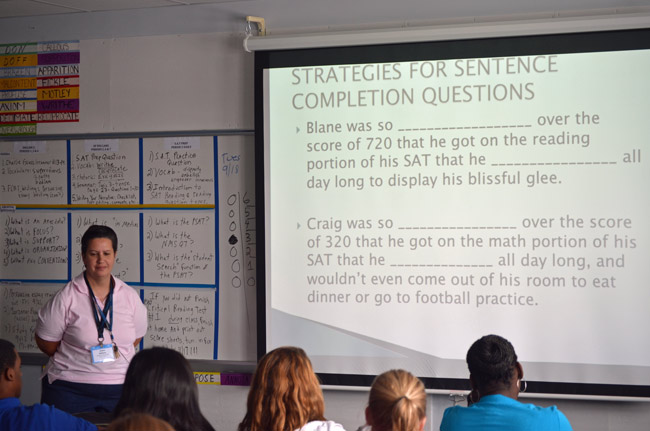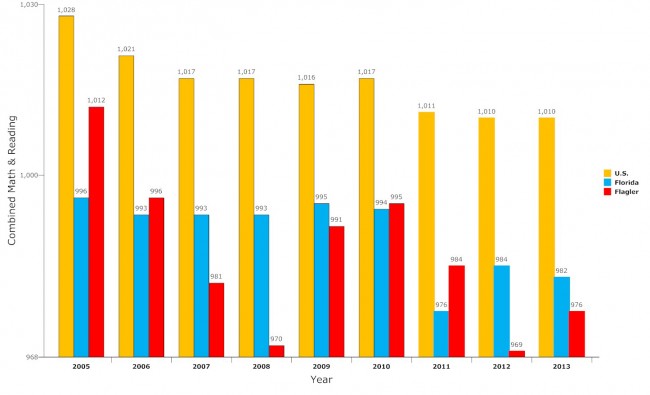
The 2013 graduating class’ 228 students who took the college-entrance exam at Matanzas averaged a 502 on the critical reading portion of the test, exceeding national and state averages by comfortable margins. The students’ 491 in math exceeded the state average by one point, but were well below the national average of 514. And in writing, a relatively new portion of the SAT test, Matanzas averaged 477, two points ahead of the state average but 11 points below the national average.
Despite the shortfall against the national averages in math and writing, Matanzas showed significant improvement in both categories in 2013, compared with 2012, improving by 10 points in math and five points in writing. The improvement in reading was 11 points.
“I was really pleased yesterday when I got the news,” Matanzas Principal Chris Pryor said Thursday. He credited the school’s SAT prep classes, which enroll just under 100 students between them, and the teachers who lead those classes: Jo Ann Nahirny leads the reading and writing classes, and Al Castle led the math classes through last year, before retiring. Julie Lavaglio now runs the math class. Students meet every other day for each. “We may want to expand that program, I think it’s working well,” Pryor said. “Joann is an awesome teacher, and I think she’s a really good writing teacher.” (Nahirny, Matanzas’s teacher of the year last year, is a FlaglerLive columnist who’s written on standardized testing.)
The numbers are more checkered when considered district-wide.
Math has always been Flagler County’s Achilles’ heel on the national test, dragging down overall scores so much that, in comparison with the state and the nation, Flagler County’s 500-odd students who take the test annually have consistently fallen well short of both averages when all is said and done, especially when the two major components of the test, the components colleges look at most—reading and math—are tallied together. In that regard, the 2013 combined score of 976 for the district remains on the lower end of the scale since 2005, and well below the 2005 peak of 1,012.
There was some improvement at Flagler Palm Coast High School as well, but only in writing. Some 277 students took the SAT at FPC. They averaged a 465 in the writing portion of the test, an improvement of eight points against last year—while the state average actually fell by one point, and the national average stayed flat. That suggests more than a fluke.
“It’s something that we’ve been focusing on recently more than we have in the past,” Schawn Schmidli, who heads the district’s testing and accountability office, said Thursday.
FPC students averaged a 483 in critical reading, a five-point decline over last year as both state and national averages stayed flat. Students at FPC averaged a 478 in math, a two-point drop from last year that places FPC’s math scores by a considerable 14 points below the state average, and an even more alarming 36 points below the national average.
The district is putting more emphasis on the SAT, however. This year, the district, through the Florida Partnership with College Board, is having its first “SAT school day” (February 26, 2014) for all Juniors. The exam, which traditionally costs $51 will be offered free of charge thanks to this partnership for all Flagler County Juniors.

“When I came to MHS when the school first opened 9 years ago, I noticed our students were not scoring as well as I thought they could on the SAT. Few, if any teachers, talked about the SAT in class, and none were providing any type of test-taking strategies for a test that I considered to be far more important than the FCAT,” Nahirny wrote in an email this afternoon. She’d been an SAT tutor in the past with one of the national SAT prep companies, and wanted to put that skill to work at Matanzas. Pryor was receptive, but it took a few years to build momentum.
The prep classes started as an after-school offering. “After about a year or two of doing this, we decided to offer it as a team-taught course,” Nahirny wrote. “We started offering it as an elective four years ago with about 25 kids, and the results were phenomenal.” The College Board says average scores can be raised an average of 20 points with prep classes. Matanzas classes raised some scores by 100 points or more.
“The program began to expand as kids and their parents recommended it. Last year we had 50 kids, this year, we have almost 100,” Nahirny wrote. “The SAT, despite what the College Board says, is a very coachable test, and I also think it’s a very good test, actually, far better than the FCAT, at determining kids academic strengths and weaknesses, and at determining college readiness. I only wish every college-bound student could have the benefit of what we are offering to these students.”
The SAT is one of two tests that measure college aptitude. The other is the ACT. But 55 percent of the students who take the ACT do so because they failed to achieve proficiency scores on either the math or reading portion of the FCAT test (or both), without which they cannot graduate. State and district rules allow students to achieve a certain grade on the ACT as an alternate way of meeting their graduation requirements. (Students can also use SAT scores for the same reason, but most going that track opt for the ACT.) To meet requirements, students must get a “concordant” score of 18 in reading, and 15 in math.
In 2012, 453 students took the ACT test. ACT scores in the district as a whole improved slightly in every category in 2013, compared with 2012—English, math, reading and science—by a range of decimal points. The composite score improved from 18.6 to 18.9. That score remains below the state average of 19.6, however. (The state average fell from 19.8).
ACT scores show a less appealing side of college readiness in Flagler: Only 48 percent of students are prepared when it comes to English composition, compared to 54 percent of students statewide. Only 29 percent of students are prepared for college algebra (as opposed to 35 percent for the state), 35 percent as prepared in the social sciences (38 percent in the state) and 22 percent are prepared in biology (22 percent).
Here’s the most arresting figure of all: only 15 percent of students in Flagler County are prepared in all four subject areas. But state proportions are very low, too: 19 percent.
That said, there’s a caveat that may explain the lower scores.
“We push our students to take the exam as many times as possible in order to earn a concordant score,” the district notes. “Many of these students are taking the exam for either a Reading OR Math concordant score, and don’t take all portions of the exam seriously. However, passing a single category on the exam can be the difference between graduating and not graduating for these students.”
ACT scores can also be the difference as to whether or not a student earns a Bright Futures Scholarship, or if they’re accepted to college
Still, the SAT and the ACT tests are the only measures of the district’s high schools in comparison with the rest of the nation, and as such provide a broader window into college readiness than does the FCAT test, which addresses only Florida standards and does not provide comparative measures with other states. That’s what Common Core standards are designed to address: the state has been strengthening Florida standards to prepare for nationally normed tests that would measure the results of Common Core’s application—or would have, until Gov. Rick Scott late last month pulled Florida out of the testing consortium that would have done just that. It’s not clear now how Florida will test students beyond FCAT 2.0, since an alternate test for Common Core that wouldn’t meet with the governor’s objections has not been developed.
![]()





























Jack D. Howell says
The ACT, SAT and ASVB, which are accepted national tests, have been used for several decades for college entrance/armed forces entry. But, they do much more! Using these tests will allow educators, politicians and parents to evaluate how the students stack up nationally against each other. It shows the trends, what areas are strong and what areas are weak. In a nut shell, these tests provide the common core make up of our educational system. And, it works! That said, why do we have to reinvent the wheel and create the “Common Core” curriculum? I have seen some of the math proposals that are being used and I can’t believe the correct responses. I also think if we examine history, the mid 60’s brought the “New Math” and the land of integers. That failed as well as the national push to convert our measurement system to metric. That failed also. Common Core is going to head in the same direction as history tends to repeat itself.
In my opinion, common core should translate to teachers, students and their parents working together. Students need to do their homework assignments, study for tests and seek help from their teachers/parents as needed. Parents need to parent and stop blaming teachers for their students failure. Parents need to get more involved in the educational process…not sit on their rear end and point fingers at everybody else but themselves. And you know, I’m glad that crap “No Child Left Behind” is gone. It was teaching false values. In the real world you either pass or fail!
I/M/O says
Congratulations to Dr. Pryor, his staff and the Teachers of Matanzas High School.
Also “Thank You” for your dedication.
Jordyn says
Keep up the good work, Matanzas students and teachers!
Amanda says
Wow, Florida scores poorly when viewed against the rest of the country. Florida education law makers really need to examine what other states are doing right rather than jumping on the bandwagon of the next bright idea by big companies seeking to make large profits! Some view this article as a positive, but I see it as a sickening reality of Florida schools.
I/M/O says
Dr. Pryor and his Teachers did an excellent job at Matanzas High School.
To bad he had to leave.
Now the new regime has to maintain the standards.